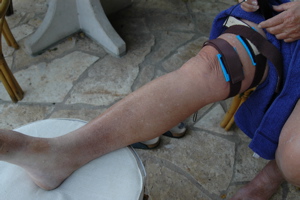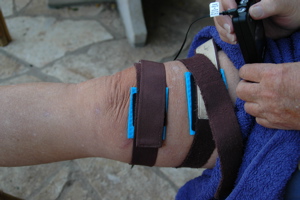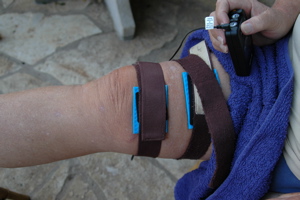It can also be used as to help prevent knee problems, and to protect the hips
What you need:
1.The muscle stimulator. A small simple one is the most practical.
2. Two electrodes for each muscle group, so if you intend to exercise the vastus medialis muscles on both legs simultaneously you need four electrodes. Preferably, one electrode should be slightly larger than the other in each pair, but this is not essential. You can use self-adhesive electrodes with a special gel to create contact with the skin, but the electrodes don’t last for very long. I prefer to use rubber electrodes with dampened sponge pads, as the electrodes don’t need replacing (unless they get damaged). Sponge pads can be cut from the household cleaning sponge cloths which are readily available in most shops selling household goods.3. For non-adhesive electrodes, you need straps to hold the electrodes in place. These can be bands with velcro fastenings, belts, or crepe bandages, for instance.
What you do:
Prepare: If you can create your own settings on your machine, you should aim at a current of 40-50 hertz (pps); contraction phase about 4 seconds, relaxation phase 10-12 seconds; if there is what is called a ramp, you can set it to 2. The ramp is the build-up time of the current, and has to be lower than the contraction time.
If you are using rubber electrodes with damp sponges, have a bowl of warm water with the sponges in it on a table beside you, t ogether with a towel so that you can wipe your hands dry when needed. Make sure the machine is switched off and place it on the table within easy reach.
ogether with a towel so that you can wipe your hands dry when needed. Make sure the machine is switched off and place it on the table within easy reach.
Position yourself: Sit comfortably with your legs straight out in front of you, on the floor, on a couch, or on a chair with your foot or feet up on a stool or support. Place a towel under your legs to avoid getting water on the furniture.
* Place the wet sponge pads along the inner side of your leg, making sure that the sponges are quite wet - don’t squeeze the water out of them. Space the sponges so that they are well apart. The upper sponge should be about two thirds of the way up the thigh, towards the hip, while the lower one should be just above the inner side of the knee. If you have different sized electrodes, the upper electrode should be the bigger one, as the smaller one, which is directly over the nerve to the vastus medialis obliquus muscle, concentrates the current where it is needed most.
* Place the electrodes over the sponges and fix them in place with the straps. If you are using self-adhesive electrodes, apply the gel to the active surface and stick the electrodes into place. Take care not to let the strap over the lower electrode press against the top of the kneecap.
* Attach the electrode lead to the machine. (When you are more practised, you can set up the electrodes when they are already attached to the machine.)
Start the action: Turn the current up on the machine. Take care to increase the current only while the pulse is active. You will feel a slight tingling from the current at first, and then as you turn it up higher, you will feel and see the muscle contracting. Don’t turn the current up too high, it should be just strong enough to create a slight movement in the muscle.
If you feel any discomfort, turn the machine off and check that the sponges are damp enough or there is enough gel on the electrodes. You can also try altering the position of the straps and the electrodes, especially the lower one. Then try again.
Activate!This is the important part. Once the electrical current is creating comfortable contractions in the vastus medialis obliquus muscle, you must activate the muscle with the current. This is what trains the nerve and muscle to work accurately and efficiently.
1. Tighten your thigh muscles slightly in time with the impulse of the current, then relax completely as the current stops. You should see your kneecap drawing upwards on the thigh and then releasing.
2. Tighten your thigh muscles more forcefully, to straighten your knee fully.
3. Place a support under your knee, such as a rolled towel, and straighten your knee over the support, trying to lift your foot off the ground. Do this if it is hard for you to sit with your leg straight out in front of you at first.
4. Place a support under your heel, such as a rolled towel or small block, and straighten your knee as hard as you can into the fully straightened position (hyperextension). Do this only in the last phase of recovery from a problem or injury.
Time, repetitions and frequency:Even if you are intending to exercise both legs simultaneously eventually, it is best to start with one leg at a time, so that you get used to the technique. Once you are confident exercising with the stimulator, you can work both legs at the same time.
* You can start with just five minutes, and build up to an hour or so if you wish. You will need to concentrate on the exercise at first, but as you become familiar with it, you will find you can do other activities such as reading or watching television while you work with the stimulator.
* You can do the slight twitching movement (“Activate” number 1) as the main part of the stimulation session, and do five repetitions of the more forceful extension exercise (number 2) at intervals. Number 4 should only be done about five times, perhaps twice within your whole session, and it should not be done if it causes pain.
* If you need to use the rolled towel under your knee (number 3), do three repetitions at a time, and relax completely in between. Only do about five minutes at a time. Try to progress as quickly as possible to placing the leg flat on the floor, and then gradually increase your session time.
* At first, you can use the stimulator two or three times a week, building up to every day if you wish. For maintenance of the vastus medialis muscle, try to use the stimulator once a week or once a fortnight as a regular routine.
Preventing knee pain: Activating the vastus medialis obliquus muscle can help head off problems if you use the stimulator whenever you have over-stressed the knees, whether by walking over hilly ground, running, skiing or cycling, or simply through sitting still for a long period, especially if your legs have been cramped, as happens in many aircraft. Using the muscle stimulator is especially useful if your knees are aching, you have had a fall, or knocked or twisted the knee. It is also surprisingly helpful if your hips have been aching: in some cases, stimulating the vastus medialis obliquus muscle can reduce or take away minor pains in the hip region. A little lightweight muscle stimulator is therefore a good thing to have at home, and to keep with you as part of your first-aid kit when you go travelling.
Care of the stimulator: Keep the machine in a box or case, out of reach of children. Always detach the electrodes after use, to avoid damaging the leads. Remove the battery if you are not going to use the machine for a considerable while.
© Vivian Grisogono 2007


